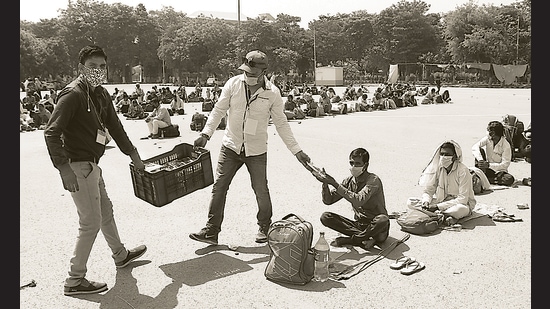Decoding the budget and the economics of welfare
Several announcements — a bad bank, the proposal for a development financial institution, and bank recapitalisation — aim at reforming the economy. But these will not respond to the structural inequalities caused by the pandemic
Covid-19 is a crisis like no other. And, expectedly, it has wreaked havoc on the Government of India (GoI)’s financial arithmetic as it struggled to deal with collapsing tax revenues and increased expenditure pressures. Therefore, there are two questions that need to be asked of the FY 2021 budget.

How did the Union government reorient its macro-fiscal position to counteract the economic fallout of the pandemic and what does this reveal about the nature of the policy choices made by the government to respond to the Covid-19-induced economic crisis? Second, what does the budget offer as a policy pathway to nurture the economy back to health in FY 2021-22?
In FY 21, the lockdown-induced freeze on the economy expectedly resulted in a collapse in revenues while expenditure pressures increased. Revenue receipts collapsed from ₹20.2 lakh crore to ₹15.5 lakh crore, expenditure increased from ₹30.4 lakh crore to ₹34.5 lakh crore, as did the one number that the government has thus far worried about the most — the fiscal deficit.
Finance minister Nirmala Sitharaman must be congratulated for breaking with tradition and being transparent about the fiscal deficit numbers while offering a path to fiscal consolidation by FY 2025-26. Importantly, she has discontinued the practice of off-budget borrowing for food subsidy. However, a closer look at the numbers reveals a more complex picture.
First, while tax revenues fell, the real hit to the Centre’s finances came from a fall in disinvestment receipts and bringing off budget expenditure back on to the budget. The fall in net tax revenue to the Centre is responsible for a mere 1% of the rise in fiscal deficit numbers. Second, most of the increase in expenditure outlays is driven by the food and fertiliser subsidy (around 80%). Increases in health accounted for 3.88%. Third, the share of states in the divisible pool of taxes fell from 32% in the budgeted estimates to 28.9% (Revised Estimates 2020-21).
Three facts emerge about the macro fiscal picture. First, the government has increasingly relied on the assumption that proceeds from disinvestment will fund its expenditure commitments. In good times, this is bad fiscal management. But in times of pandemic, this can be seriously damaging. The government’s reluctance to adopt an expansionary fiscal stance in response to the pandemic is a consequence of historical fiscal mismanagement rather than the Covid-19-induced economic shock. The emphasis on disinvestment in this budget, while welcome, risks a similar fate. The government will have to urgently double down in FY 22 to meet these targets.
Second, expenditure increases in FY 21 were limited to subsidies and essential relief through the Mahatma Gandhi National Rural Employment Guarantee Scheme (MGNREGS). Overall, in FY 21, expenditure increased from a 13.53% of GDP Budget Estimates (BE) to 17.74% in RE. However, because GDP contracted significantly in FY 21, these numbers overstate the magnitude of increase in expenditure. It is important to note that transfers from centrally-sponsored schemes (including MGNREGS whose allocations increased by 81% over budget estimates) increased by 14%, suggesting significant contraction in expenditure for other schemes in FY 21. Finally, state governments, at the frontlines of the Covid-19 battle, have been forced to rely on market borrowing as their share in the central government taxes fell significantly. The consequences of this on state budgets, that have displayed far greater fiscal discipline than the Centre will be significant, in the long-term.
As this column noted in a pre-budget piece, the post-lockdown economic recovery is showing signs of deepening structural inequality. Economic activity has reached near pre-pandemic levels, but this is largely profit-led. Large listed firms have profited at the cost of small firms and the informal sector. And the scars in the labour market, particularly informal labour, run deep. Reversing this trend is both a moral imperative and good economic sense — after all, if purchasing power remains low for the bulk of the economy, demand will collapse.
In this context, the FY 22 budget ought to have increased expenditure for welfare, provided for an inclusive social protection architecture that protects vulnerable groups especially migrant workers, and increased capital expenditure. At first glance, the government has only done the last.
Several important announcements have aimed at reforming what economist Arvind Subramanian has called the “software” — a bad bank, the proposal for a DFI, and bank recapitalisation. All of these are steps in the right direction. However, these increases will not immediately translate into employment and increased wages for the poor.
There are continuing governance challenges, which will not be addressed overnight. In this context, it is a mistake to assume that FY 22 will present space to the government to curtail its welfare expenditures. But the FY 22 budget cuts allocations to food subsidy and MGNREGS. It offers no comfort that the government, in response to the migrant crisis, will address the extreme vulnerabilities faced by India’s informal sector and urban workers. Expenditure in FY 22 will see little planned growth over FY 21.
The pandemic has disproportionately impacted India’s poor and vulnerable. The hope was that this budget would, by adopting an expansionist fiscal stance, respond to their needs while putting the economy back on track. It has not.
Yamini Aiyar is president and chief executive of the Centre for Policy Research
The views expressed are personal



